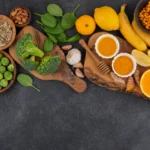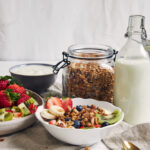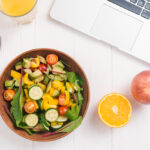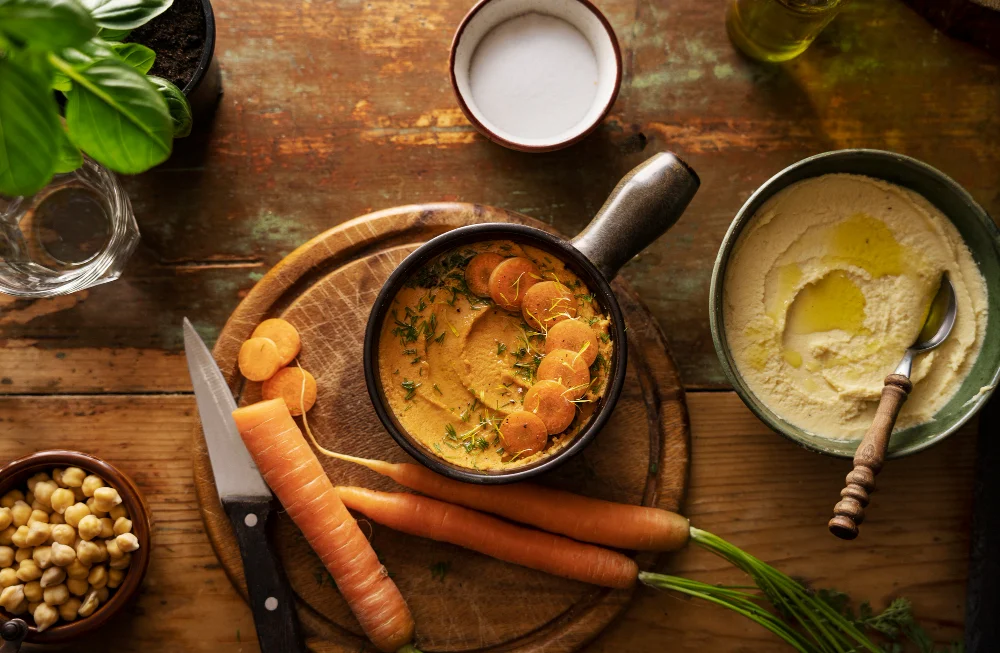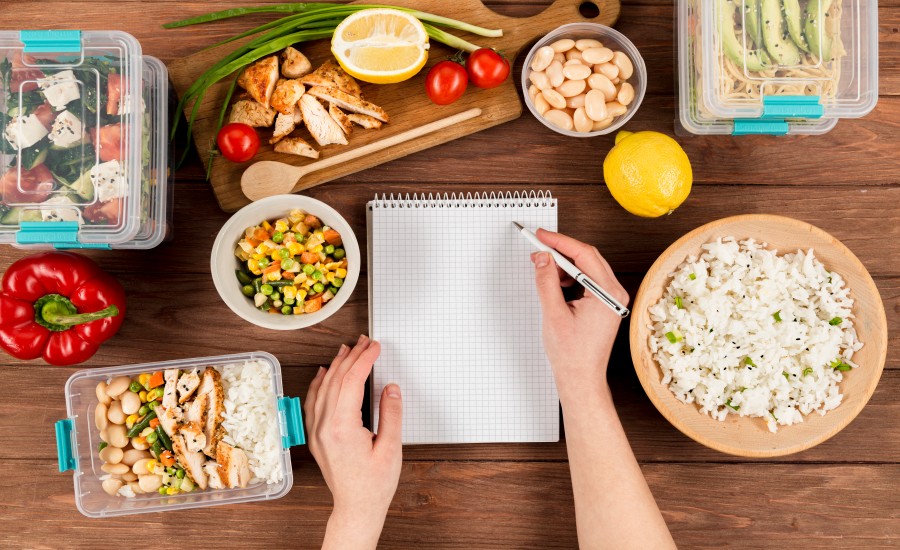In the hustle and bustle of modern life, finding quick, nutritious ways to fuel our bodies is essential. Smoothies have soared in popularity as a convenient solution, and energizing vegan smoothies, in particular, offer a powerful way to boost vitality using plant-based ingredients. But what truly makes a smoothie energizing? This guide dives deep, exploring delicious recipes alongside the nutritional science of energy, ethical ingredient sourcing, environmental considerations, and practical tips from everyday life. Get ready to blend your way to sustained energy and vibrant well-being, right from your kitchen in Siyol or wherever you may be!
LENS 1: Nutritional Analysis (The Science of Energy)
A truly energizing smoothie isn’t just about packing in ingredients; it’s about balancing them to provide sustained fuel and support metabolic processes.
- Macronutrient Synergy:
- Complex Carbohydrates: Fruits (like bananas, mangoes, berries – use local Rajasthani options when possible!), rolled oats, and even vegetables (spinach, kale) provide glucose, the brain’s primary fuel, and energy for muscles. Whole food sources release energy more steadily than refined sugars.
- Protein: Crucial for satiety, preventing energy crashes, and supporting muscle maintenance/repair. Add plant-based protein powder, nuts (almonds, walnuts), seeds (chia, flax, hemp, pumpkin), nut butters, silken tofu, or protein-rich plant milks (like soy).
- Healthy Fats: Slow down digestion, promoting stable blood sugar and sustained energy release. Fats also help absorb fat-soluble vitamins (A, D, E, K). Good sources include avocado, nuts, seeds, and coconut milk/yogurt (in moderation).
- Fiber is Your Friend: Fiber, abundant in fruits, vegetables, oats, nuts, and seeds, further slows sugar absorption, preventing energy spikes and subsequent slumps. It also feeds beneficial gut bacteria (see Gut-Brain Axis).
- Micronutrients for Metabolism: Many vitamins and minerals are vital cofactors in energy production pathways:
- B Vitamins (especially B12): Essential for converting food into energy. Vegans must get B12 from fortified foods or supplements. Leafy greens, nuts, seeds, and legumes provide other B vitamins like folate.
- Iron: Needed for oxygen transport; deficiency causes fatigue (plant sources: spinach, lentils, seeds – consume with Vitamin C for better absorption).
- Magnesium: Involved in hundreds of enzymatic reactions, including ATP (energy currency) production (sources: nuts, seeds, leafy greens, dark chocolate).
- Hydration & Antioxidants: Smoothies contribute to hydration, essential for energy levels. Antioxidants from fruits and vegetables combat oxidative stress, which can contribute to fatigue. How can you balance carbs, protein, and fat in your next smoothie for longer-lasting energy?
Nutritional Deep Dive: Macronutrient Balance for Sustained Energy Release
A smoothie made only of fruit juice and fruit provides a quick sugar rush (rapid glucose absorption) followed by a potential crash as insulin works overtime. Adding protein, healthy fats, and fiber significantly slows down the digestion and absorption of carbohydrates. This leads to a gentler, more gradual rise in blood sugar and a longer, more stable release of energy, keeping you feeling energized and focused for hours instead of minutes. Aim for a combination of all three macronutrients plus fiber in every energizing smoothie.
Voice of Experience (Registered Dietitian): “An energizing smoothie is all about balance. Combine carbohydrate sources like fruit or oats with protein from seeds, nuts, or plant-based protein powder, and healthy fats like avocado or chia seeds. This trifecta ensures sustained energy release, preventing those drastic blood sugar swings and keeping you fueled longer. And don’t forget hydration and essential micronutrients like B12!” – Priya Singh, RD
LENS 2: Ethical Framework (Mindful Consumption)
Choosing ingredients for your energizing vegan smoothie offers opportunities to extend ethical considerations beyond simply being plant-based.
- Source Matters: Consider the origin of your ingredients:
- Fair Trade: Look for fair-trade certified bananas, cocoa powder, coffee (if using), vanilla, and spices to ensure farmers receive fair wages and work under better conditions.
- Local & Seasonal: Prioritize locally grown fruits available in your region (like mangoes, papayas, bananas, pomegranates in parts of Rajasthan during their season) to support local farmers and reduce food miles.
- Organic: Choosing organic reduces pesticide exposure for farmworkers and consumers and supports healthier ecosystems.
- Beyond the Hype: Be critical of marketing claims around expensive, imported “superfoods.” While some offer benefits (like chia or flax seeds), focus on nutrient-dense whole foods that are accessible and sustainably sourced rather than chasing exotic trends. Often, local equivalents offer similar benefits.
- Minimizing Food Waste: Smoothies are perfect for using up slightly overripe fruits (especially bananas!), wilting greens (spinach, kale), or leftover cooked sweet potato/pumpkin. Blend, don’t trash!
- Mindful Ritual: Preparing and consuming a smoothie can be a mindful act of self-care. Taking a few moments to appreciate the nourishment you are providing your body aligns well with the compassionate principles often underlying veganism. How can you make your smoothie choices more ethically sourced or locally focused?
Hidden Benefits: Connection to Source
Choosing local or fair-trade ingredients fosters a greater connection to the food system and the people who produce our food. This awareness can add a layer of meaning and satisfaction to the simple act of making a smoothie.
Voice of Experience (Ethical Food Advocate): “An energizing smoothie feels even better when you know the ingredients were sourced ethically. Choosing fair-trade cocoa or local, seasonal fruits connects your personal health choice to the well-being of producers and the planet. It’s about conscious consumption, even in a quick blend.” – Aarav Jain, Sustainable Food Blogger
Critical Reassessment: Balancing Ideals and Practicality
While striving for ethical and local sourcing is commendable, recognize that accessibility and cost can be barriers. Focus on making the best choices available to you without undue stress. Using frozen berries shipped from afar might still be a better overall choice than dairy milk if ethical veganism is the primary driver. Find your balance.
LENS 3: Ingredient Science & Environment (Sustainable Blending)
Understanding how ingredients behave in the blender and their environmental impact allows for smarter, more sustainable smoothie creation.
- Texture Science:
- Frozen Fruit/Veg: Key for thick, creamy, cold smoothies without diluting flavour with ice (frozen bananas are magic!).
- Creaminess: Avocado, nut butters, seeds (chia/flax gel), plant yogurts, silken tofu, or canned coconut milk add richness and smooth texture.
- Liquid Level: Adjust plant milk or water amount for desired consistency (less liquid = thicker smoothie/bowl).
- Nutrient Absorption: Adding healthy fats (avocado, nuts, seeds) helps your body absorb fat-soluble vitamins (A, D, E, K) present in greens and fruits.
- Environmental Footprints:
- Plant Milks: Water usage varies significantly. Oat and soy generally have lower water and carbon footprints than almond milk. Making your own plant milk at home reduces packaging waste.
- Food Miles: Choosing local, seasonal fruits (like Rajasthani dates or pomegranates) over air-freighted exotic berries drastically reduces transport emissions.
- Waste Reduction: Opt for reusable smoothie cups, lids, and straws instead of single-use plastics. High-quality blenders tend to last longer, reducing electronic waste compared to cheap, disposable ones. Could you swap an imported ingredient in your favorite smoothie for a local, seasonal alternative?
Market Transformation Map Suggestion: Graphs showing the decline in single-use plastic straw usage alongside the rise in sales of reusable metal, bamboo, or glass straws and reusable smoothie tumblers.
Voice of Experience (Sustainable Food Systems Expert): “Smoothies can be very sustainable if made thoughtfully. Prioritize plant milks with lower water footprints like oat or soy, use seasonal and local fruits whenever possible to cut down on food miles, utilize frozen fruits to minimize food waste, and always opt for reusable containers.” – Dr. Priya Desai, Environmental Nutritionist
LENS 4: Everyday Practitioner’s Experience (Recipes & Reality)

This is where the blender meets the ingredients – practical tips and delicious recipes.
Best Energizing Vegan Smoothie Recipes for Energy Boost
(Adjust liquid for desired consistency; use frozen fruit for thickness; add protein powder as needed)
- Green Energy Monster:
- 1 cup Spinach or Kale (packed)
- 1 cup Plant Milk (unsweetened)
- 1/2 Frozen Banana
- 1/2 Green Apple or Pear
- 1 tbsp Chia Seeds or Flax Seeds
- 1 tbsp Almond Butter (optional, for richness)
- Boost: Add a scoop of vegan protein powder.
- Berry Blast Off:
- 1 cup Mixed Berries (frozen)
- 1 cup Plant Milk or Coconut Water
- 1/2 Frozen Banana
- 1 tbsp Hemp Seeds
- Squeeze of Lime/Lemon Juice (optional, brightens flavour)
- Boost: Add 1/4 cup rolled oats for extra fiber/carbs.
- Choco-Nut Powerhouse:
- 1 cup Plant Milk (e.g., soy or cashew)
- 1 Frozen Banana
- 2 tbsp Peanut Butter or Almond Butter
- 1 tbsp Cocoa Powder (unsweetened)
- 1 tbsp Flax Seeds
- 1-2 Dates (Khajoor) or dash of Maple Syrup/Jaggery (optional, for sweetness)
- Boost: Add a scoop of chocolate vegan protein powder.
- Tropical Sunshine Boost (Local Adaptation):
- 1 cup Coconut Water or Plant Milk
- 1/2 cup Frozen Mango chunks
- 1/2 cup Pineapple chunks (fresh or frozen)
- 1/2 Frozen Banana
- 1 tbsp Chia Seeds
- Small piece of fresh Ginger (Adrak) or Turmeric (Haldi) (optional, anti-inflammatory)
- Boost: Add 1/4 cup silken tofu for creaminess and protein.
Practical Tips & Tricks:
- Prep Smoothie Packs: Combine non-liquid ingredients (fruit, veg, seeds, powders) in freezer bags for quick blending later. Just add liquid!
- Freeze Your Bananas: Peel ripe bananas, break into chunks, and freeze on a tray before transferring to a bag. Perfect base for thick smoothies.
- Start Liquid First: Add liquid to the blender first, then soft items, then greens, then frozen items/ice/powders. Helps blend smoothly.
- Taming Greens: Blend greens thoroughly with the liquid before adding other ingredients to avoid leafy chunks. Start with milder greens like spinach if new to green smoothies.
- Balance Flavours: If too tart, add a bit more banana or a date. If too sweet, add lemon/lime juice or unsweetened greens. If bland, add vanilla, cinnamon, or ginger.
- Choosing a Blender: High-speed blenders (like Vitamix/Blendtec) create smoother results, especially with tough greens or seeds, but standard blenders work well, especially if you blend longer or avoid very fibrous ingredients.
- Cleaning Hack: Immediately after pouring your smoothie, add warm water and a drop of soap to the blender jar and blend for 30 seconds. Rinse well. What’s your go-to combination for an energizing smoothie?
Daily Impact: Smoothie Prep Station
Designate a small area in your kitchen with your blender, reusable cups, straws, and easily accessible pantry staples like seeds, nuts, protein powder, and cocoa. Keep prepped smoothie packs or frozen fruit handy in the freezer.
Voice of Experience (Busy Parent): “Energizing smoothies are my morning lifesaver! I prep freezer packs on weekends. In the morning, I just dump a pack in the blender, add plant milk, blend, and go. It guarantees I get good nutrition and energy even on the busiest days.” – Sunita Sharma, Mother & Entrepreneur
Alternative Approaches: Smoothie Bowls & Add-Ins
- Smoothie Bowls: Make smoothies extra thick (less liquid), pour into a bowl, and top with granola, nuts, seeds, fresh fruit for texture and extra nutrients.
- Caffeine Boost: Add cooled brewed coffee/espresso or matcha powder for an extra kick (use mindfully).
- Adaptogens: Some add powders like maca or ashwagandha (research quality and effects).
PERSPECTIVE INTERSECTION MATRIX
- Nutrition & Recipes (Lens 1 & 4): Nutritional principles of balanced macronutrients and micronutrients (Lens 1) directly inform the specific ingredients and combinations in the recipes (Lens 4).
- Ethics & Ingredients (Lens 2 & 4): Ethical considerations regarding sourcing (Lens 2) influence the selection of fruits, sweeteners, and add-ins used in practice (Lens 4).
- Environment & Practice (Lens 3 & 4): Awareness of environmental footprints (Lens 3) guides choices towards sustainable plant milks, local produce, and reusable containers in daily smoothie making (Lens 4).
- Science & Texture (Lens 3 & 4): Understanding how freezing or specific ingredients affect texture (Lens 3) helps practitioners achieve desired smoothie consistency (Lens 4).
- Holistic Energy (All Lenses): True sustained energy comes from a combination of balanced nutrition (Lens 1), mindful consumption (Lens 2), sustainable choices (Lens 3), and practical enjoyment (Lens 4).
MISCONCEPTION ANALYSIS
| Misconception | Reality |
| All smoothies are inherently healthy and energizing. | Smoothies can be loaded with sugar (from juice, excessive fruit, added sweeteners) and low in fiber/protein/fat, leading to energy crashes. Ingredient balance is crucial for health and sustained energy. |
| Drinking smoothies leads to blood sugar spikes. | Fruit-only or juice-based smoothies can. However, balancing smoothies with fiber (whole fruits/veg/oats), protein (seeds/nuts/powder/tofu), and healthy fats significantly slows sugar absorption and promotes stable blood sugar. |
| You can’t get enough protein in a vegan smoothie without powder. | While powder is convenient, combining protein-rich plant milk (soy), nuts/nut butters, seeds (hemp, chia, pumpkin), oats, or even silken tofu can provide substantial protein. |
| Smoothies aren’t filling and leave you hungry quickly. | Smoothies lacking protein, fat, and fiber can be unsatisfying. Adding these elements significantly increases satiety, making a well-formulated smoothie a filling meal replacement or snack. |
| Blending destroys nutrients, especially fiber. | Blending breaks down cell walls, making some nutrients more accessible. It changes fiber structure but doesn’t destroy it; the fiber is still present and beneficial for digestion and blood sugar control. Extreme heat can degrade some vitamins, but typical blending doesn’t. |
KEY TURNING POINTS
- Invention & Mass Marketing of the Electric Blender (Mid-20th Century): Made smoothie creation accessible to households.
- Rise of Health & Wellness Movement (Late 20th Century onwards): Promoted fresh juices and later smoothies as healthy options.
- Increased Availability of Frozen Fruits & Diverse Plant Milks: Made creating varied, thick, and creamy vegan smoothies much easier year-round.
- Popularization of “Superfoods” (Chia, Flax, Acai, etc.): Became common smoothie add-ins, boosting perceived health value.
- Mainstreaming of Veganism & Plant-Based Eating: Led to widespread acceptance and sharing of vegan smoothie recipes and dedicated smoothie bars.
SYNTHESIS & RECOMMENDATIONS
Energizing vegan smoothies offer a delicious, convenient, and potent way to fuel your body and mind when crafted thoughtfully. The key to unlocking sustained energy lies not just in the plant-based nature, but in the balance of complex carbohydrates, protein, healthy fats, and fiber. By understanding the nutritional science, making mindful choices about ethically and sustainably sourced ingredients, and mastering a few practical blending techniques, you can easily create smoothies that truly nourish and invigorate. Embrace the versatility, experiment with flavours (especially local ones!), and enjoy the vibrant energy that comes from well-made, plant-powered blends.
Recommendations:
- Balance Your Blend: Always aim to include a source of carbs (fruit/oats), protein (seeds/nuts/powder/tofu), healthy fat (avocado/nuts/seeds), and fiber (from whole ingredients).
- Prioritize Whole Foods: Use whole fruits and vegetables over juices whenever possible for maximum fiber and nutrients.
- Freeze for Thickness: Use frozen fruits (especially bananas) for creamy, cold smoothies without needing ice.
- Boost with Protein/Fat: Don’t shy away from adding nuts, seeds, avocado, or protein powder to increase satiety and sustain energy.
- Source Mindfully: Choose local, seasonal, fair-trade, or organic ingredients when feasible. Opt for sustainable plant milks.
- Hydrate Smartly: Use water, coconut water, or unsweetened plant milk as your liquid base.
- Prep Ahead: Make smoothie packs for quick and easy blending on busy days.
- Listen to Your Body: Adjust recipes based on your energy needs, taste preferences, and how different combinations make you feel.
FURTHER AREAS OF EXPLORATION
- A Deep Dive into Vegan Protein Powders (Taste, Texture, Nutrition)
- Creative Vegan Smoothie Bowl Toppings
- Smoothies vs. Juicing: Pros and Cons
- Incorporating Indian Spices (Cardamom, Saffron) into Smoothies
- Smoothies for Specific Goals (Post-Workout Recovery, Weight Management)
- Kid-Friendly Energizing Vegan Smoothie Ideas
- Troubleshooting Common Smoothie Problems (Separation, Bitterness, etc.)




